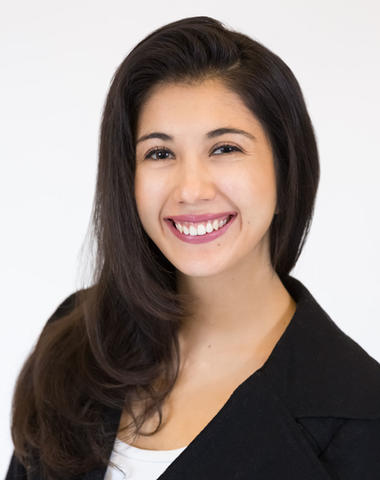
Nathalia Torres Jimenez
Thesis Title:
The Role of D-Serine in Normal Retinal Function and Implications for Psychiatry
Current Position:
Senior Engineer, Stryker
Undergraduate Institution and Major:
University of California San Diego, B.S. in Cognitive Science specialized in Neuroscience, 2011
Past Position(s):
Postdoctoral research and senior data analyst, University of Minnesota
Graduate Advisor:
Linda McLoon, Ph.D., Department of Ophthalmology and Visual Neurosciences, Department of Neuroscience and Robert Miller MD, Department of Neuroscience
Description of Graduate Research:
I am studying the potential of the flash electroretinogram (fERG) for use as a predictor of individuals with schizophrenia prior to the onset of symptoms. The advantage of the fERG as a diagnostic tool is that the technique is relatively non-invasive, easy to administer, and its major waves have a known cellular origin. I am using a mouse model of schizophrenia characterized by NMDA receptor hypofunction due to a mutation in the gene for the enzyme serine racemase. This results in a dramatic reduction in the levels of D-serine. Our data suggest that the fERG prognostic capability may be improved by examination of a larger array of light intensities, considering sex as a variable, and performing Fourier transform analyses of all wave forms. This should improve ability to differentiate between healthy controls and subjects with schizophrenia, characterized by NMDAR hypofunction.
Graduate Publications:
- Torres Jimenez N, Miller RF, McLoon LK. Effects of D-serine treatment on outer retinal function. Experimental Eye Research. Exp Eye Res. 2021 Aug 20;211:108732.
- Torres Jimenez N, Lines JW, Kueppers RB, Kofuji P, Wei H, Rankila A, Coyle JT, Miller RF, McLoon LK. Electroretinographic abnormalities and sex differences detected with mesopic adaptation in a mouse model of schizophrenia: a and b wave analysis. Invest Ophthalmol Vis Sci. 2020 Feb 7;61(2):16.
- Moghimi P*, Torres Jimenez N*, McLoon LK, Netoff TI, Lee MS, MacDonald III A, Miller RG. Electroretinographic evidence of altered retinal function in schizophrenia. PMID: 31615740. Schizoprenia Research. 2020;219:34-46. * co-first authors
- Abu-Odeh D, Dziobek D, Jimenez NT, Barbey C, Dubinsky JM. Active learning in a neuroethics course positively impacts moral judgment development in undergraduates. J Undergrad Neurosci Educ. 2015;13(2):A110-119.
Graduate Abstracts:
- Torres NJ, Gustafson E, Miller RF. The synaptic basis of the pattern-electroretinogram (PERG). Program No 759.10 2015 Neuroscience Meeting Planner. Chicago, IL: Society for Neuroscience, 2015.
- Torres NJ, Gustafson E, Miller RF. The synaptic basis of the PERG. Invest Ophthalmol. Vis. Sci. ARVO Abst. 2015;56:193.
Professional Presentations:
- Torres Jimenez N, Lines J, Kofuji P, Wei H, Rankila A, Coyle JT, McLoon LK, Miller RF.. Electroretinographic abnormalities and sex differences in an NMDAR hypofunction mouse model of schizophrenia: A and B wave analysis. Annual Spring Vision Symposium. Minneapolis, MN. April 2019.
- Torres Jimenez N, Gustafson E, Miller RF. The synaptic basis of the pattern-electroretinogram (PERG). Poster presented at the Society for Neuroscience Scholars’ Diversity Poster, Chicago, IL, Oct 17, 2015.
- Torres Jimenez N, Miller RF. Dissecting the pattern-electroretinogram. Oral presentation at GPN Colloquium Series, University of Minnesota, Minneapolis, MN, 2017, 2016, 2015.
- Torres Jimenez N, Gustafson E, Miller RF. The synaptic basis of the pattern-electroretinogram (PERG). Poster presented at the Annual Spring Vision Symposium, April 2018, 2017, 2016, 2015, 2014.
Graduate Awards and Honors:
- T32 NIH Vision Training Grant Fellowship 2017-2019
- F31 Ruth L. Kirschstein National Research Service Award, 2014
- Sping and Ying Ngoh Lin Award, 2014
- Honorable Mention, National Science Foundation Graduate Fellowship Application, 2014
GPN Committees:
- Marketing and Recruitment Committee, Founding Member, 2015 - 2017
- Career Facilitation Committee, Founding Member, 2015 -2017
- Student Board, Second and Third year representative, 2013 – 2015
Other Committee Involvement:
- Association of Multicultural Scientist, Officer, 2015-present
Professional Outreach:
- Science Fusion- ¡Amantes de la Ciencia! Presenter, Science Museum of Minnesota, St Paul, MN, Jan. 2016
- Brain Awareness, Borroughs Community School, Instructor, Minneapolis, MN, Nov. 2015
- Science Fusion - ¡Amantes de la Ciencia! presenter, Science Museum of Minnesota, St Paul, MN, Jan. 2015
- Brains at the State Fair presenter, Minnesota State Fair, St Paul, MN Sept. 2013
Internships:
- Advanced Professional Degree Consulting Club Internship Program, Medical engineering, Spring 2015
Professional Memberships:
- Society for Neuroscience, 2015 – present
- Association for Research in Vision and Ophthalmology, 2015-Present
Thesis Committee Members:
- Eric Newman, Ph.D, Department of Neuroscience (Chair)
- Linda McLoon, Ph.D. Department of Ophthalmology and Visual Neurosciences
- Paulo Kofuji, Ph.D., Department of Neuroscience
- Angus MacDonald III, Ph.D., Department of Psychology
Research Categories:
- Vision Neuroscience
- Neuropsychiatric Disease
Rotations:
- Jose Pardo, M.D., Ph.D., Department of Psychiatry
- Mark Masino, Ph.D., Department of Neuroscience
- Robert F. Miller, M.D., Department of Neuroscience
Why Did You Choose MN?
Upon graduating from UCSD with a degree in Cognitive Science, I realized I wanted to learn more about the cellular basis of the cognition I studied. Therefore, I decided to pursue a Neuroscience graduate degree at Minnesota because its academic curriculum provides the cellular and molecular knowledge I was yearning to learn more about. By the end of the first year, each student possesses a thorough understanding of neuroscience, from development, cellular, behavior/cognitive and systems perspectives which perfectly complemented my cognitive background.
What Advice Would You Give a First Year Graduate Student?
Take advantage of rotations to explore and learn about different fields and techniques. This allows you to not only gain more neuroscience knowledge but will provide you with an informed decision on lab placement. In essence, rotations allows you to “shop-around” for what will become your second home for the next four years. My advice is to begin communication with your preferred PI early. If you already have someone in mind, perhaps working on a grant together, such as the National Science Foundation Graduate Fellowship, will allow you to evaluate and forecast the relationship you will have with that person.
